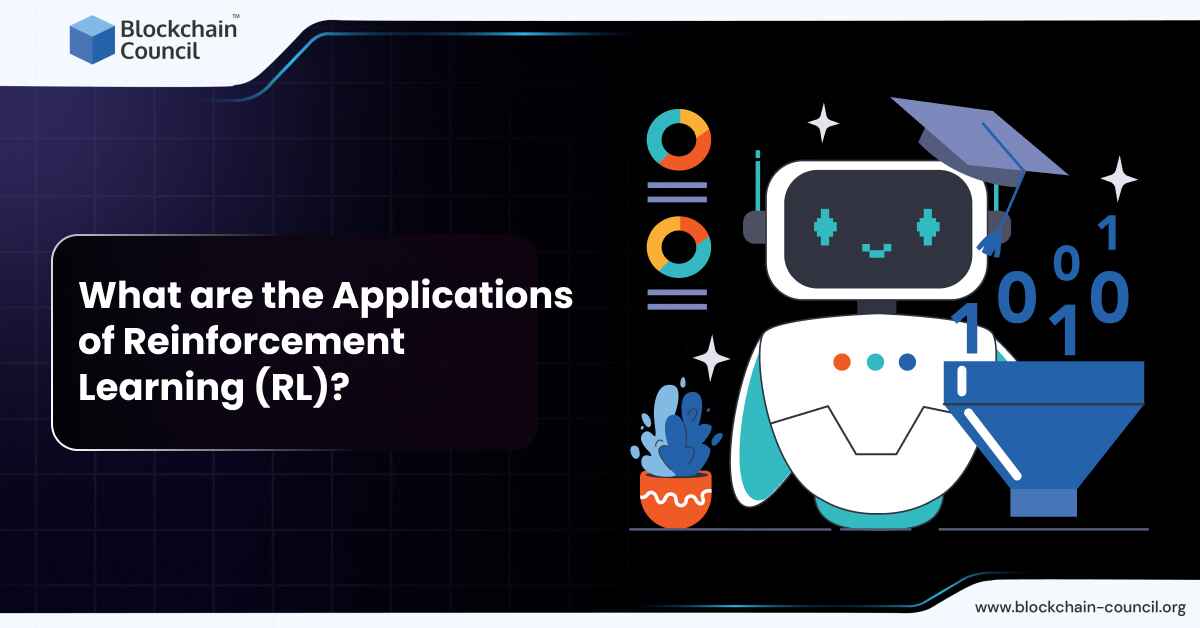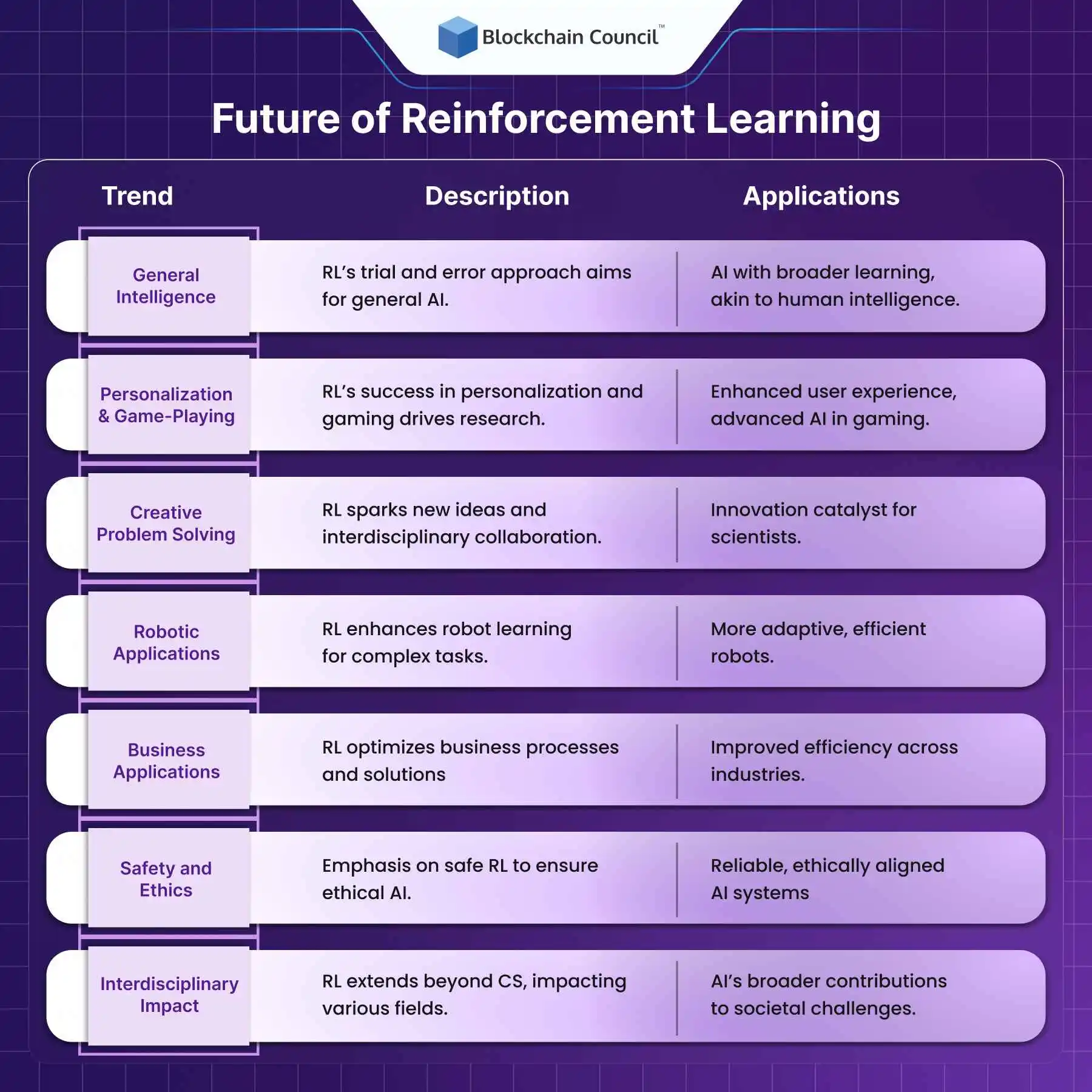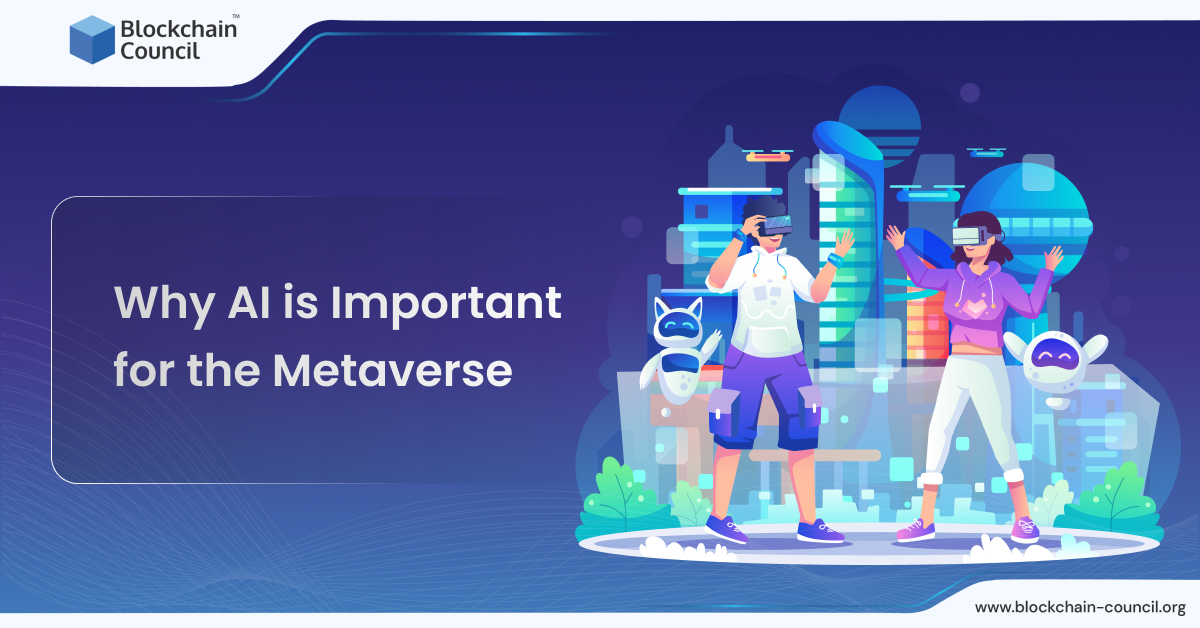
- Blockchain Council
- January 15, 2025
Summary
- Reinforcement Learning (RL) is a powerful form of machine learning where agents learn through trial and error to achieve goals, akin to learning to ride a bike by experimenting.
- RL applications span various sectors, including healthcare, energy management, finance, NLP, engineering, automotive, transportation, customer service, marketing, and gaming.
- In healthcare, RL is used for personalized treatment plans, like managing Type 1 diabetes, improving outcomes, and quality of life.
- Energy management benefits from RL’s optimization algorithms, as seen in projects like DeepMind’s partnership with Google Data Centers, reducing energy consumption significantly.
- RL models in finance and trading automate trading strategies, potentially outperforming traditional methods and optimizing portfolio returns.
- RL enhances NLP processes such as policy formulation, dialogue generation, machine translation, text summarization, and question answering.
- In engineering and manufacturing, RL enables robots to become more autonomous and efficient, exemplified by Fanuc’s incorporation of deep RL into its robots.
- RL drives advancements in the automotive industry, particularly in self-driving cars, trajectory optimization, and dynamic pathing.
- Transportation and urban planning benefit from RL’s optimization of traffic flow, urban development strategies, and spatial planning of urban communities.
- RL enhances customer service by adapting strategies based on customer history and preferences, improving interaction and recommendation systems.
- RL’s future lies in broader applications such as general intelligence, personalization, creative problem solving, robotic applications, business optimization, safety, ethics, and interdisciplinary impact
Reinforcement Learning (RL) is a powerful branch of machine learning where agents learn to make decisions by trying things out in an environment to achieve a goal. It’s like learning to ride a bike: you try different approaches and learn from mistakes until you get it right. This method is revolutionizing various fields, offering solutions that were previously unimaginable. In this article, we dive into the fascinating world of RL applications, showcasing its versatility and transformative potential across industries.
What is Reinforcement Learning?
As stated earlier, Reinforcement Learning (RL) is a type of machine learning technique that enables an agent to learn in an interactive environment by trial and error using feedback from its own actions and experiences. This approach is similar to how humans learn from the consequences of their actions. Unlike other machine learning approaches, which involve training on a dataset provided in advance, RL is focused on goal-directed learning from interaction.
This means it involves an agent that makes decisions, an environment with which it interacts, actions it can take, and rewards that guide its learning. The agent learns to achieve a goal by experimenting within its environment, using feedback to understand the consequences of its actions. This feedback helps the agent refine its strategy to maximize rewards over time.
Significance in the AI Landscape
RL is significant in the AI landscape because it simulates the learning process more closely to how humans and animals learn by interacting with their environment. This approach has been pivotal in solving complex, dynamic problems that are difficult to address with traditional supervised and unsupervised learning methods. It’s especially powerful in scenarios where the model must make a sequence of decisions that lead to a long-term reward, making it essential for tasks like robotic control, game playing, autonomous driving, and personalized recommendations.
Also Read: What is Reinforcement Learning (RL)?
How RL Differs from Other Machine Learning Approaches
The main difference between RL and other machine learning approaches lies in its learning process. In supervised learning, the model learns from a dataset that includes both input and expected output, aiming to find a mapping between the two. In unsupervised learning, the model tries to learn patterns or structures from data without explicitly provided outputs. However, RL operates through an agent that makes decisions, receives feedback through rewards or penalties, and adjusts its actions accordingly. This feedback loop allows the RL agent to learn the best actions to take in various states, optimizing for a cumulative reward over time.
Top 10 Applications of Reinforcement Learning
Healthcare
In the healthcare sector, Reinforcement Learning has been applied to personalize treatment plans for patients, leading to improved outcomes. A notable project is the use of RL in managing Type 1 diabetes. The Artificial Pancreas System, for example, utilizes RL algorithms to monitor and adjust insulin levels in real-time, significantly improving the quality of life for individuals with diabetes by maintaining optimal blood glucose levels. This application of RL demonstrates its potential in creating adaptive, personalized healthcare solutions that can manage chronic conditions more effectively than traditional methods.
Energy Management
The energy sector has also benefited from the adoption of Reinforcement Learning, particularly in optimizing energy consumption and improving efficiency in power grids. The DeepMind project with Google Data Centers is a prime example of RL’s application in energy management. By applying RL algorithms, DeepMind was able to reduce cooling energy consumption by 40%, showcasing significant energy efficiency improvements. This application not only supports sustainable practices but also demonstrates the cost-saving potential of RL in large-scale industrial operations.
Finance and Trading
In finance and trading, Reinforcement Learning has been used to develop sophisticated models that can predict market movements and automate trading strategies. One of the standout applications is the development of autonomous trading agents. These agents, through RL, learn to make trading decisions based on historical and real-time market data, potentially outperforming traditional trading strategies. For instance, investment firms have started integrating RL-based models into their trading algorithms to optimize portfolio returns and manage risk more effectively.
Natural Language Processing (NLP)
In NLP, RL has been employed to refine and improve several processes:
- Policy Formulation in Documentation: RL algorithms are trained to sift through extensive policy documents, optimizing the process of identifying effective policies across various domains, including healthcare and chronic disease management.
- Dialogue Generation: Chatbots have been optimized using RL to produce more customer-centric results, enhancing conversational quality and informativity.
- Machine Translation: RL aids in real-time translation between languages by managing conditional word distributions, improving the translation quality without sacrificing accuracy.
- Abstractive Text Summarization: By employing RL, AI models can generate concise summaries of lengthy documents, ensuring accuracy and coherence.
- Question Answering: RL strategies are used to train systems to reformulate questions to elicit optimal answers, enhancing the quality of responses through active question answering.
Also Read: Key Features of Reinforcement Learning
Engineering and Manufacturing
In the realm of manufacturing, RL has enabled robots to become more autonomous and efficient. A prime example is Fanuc, a Japanese company that has incorporated deep RL into its robots, enabling them to learn and perform tasks such as object picking and placing with increasing efficiency. This application of RL demonstrates a significant leap towards creating more intelligent and versatile robotic systems in manufacturing.
Automotive Industry
The automotive industry is witnessing significant advancements with the application of RL, particularly in self-driving cars. RL algorithms are being used for trajectory optimization, motion planning, dynamic pathing, and controller optimization, among other tasks essential for autonomous driving. A notable example includes AWS DeepRacer, an autonomous racing car designed to test RL models on physical tracks, utilizing cameras for navigation. Wayve.ai has also made remarkable progress by employing deep RL for lane following tasks, demonstrating the ability of a car to learn driving in a day. Moreover, research by Cao et al. highlights the use of dynamic confidence-aware reinforcement learning to prevent autonomous vehicles from causing accidents, emphasizing the continuous improvement and safety measures in self-driving technologies.
Transportation and Urban Planning
In the realm of transportation and urban planning, RL is being utilized to optimize traffic flow and urban development strategies. For instance, deep reinforcement learning has been applied to dynamic urban transportation problems, leveraging neural network architectures like Multi-Layer Perceptron (MLP) and Autoencoders to calibrate transportation simulators. These models help in accurately predicting traffic flow, reducing congestion, and enhancing overall transportation system efficiency. The Sioux-Falls transportation model demonstrates how RL can calibrate traffic demand matrices, resulting in simulations that closely match real-world traffic patterns, thus facilitating more efficient urban planning and traffic management.
Moreover, RL has been instrumental in spatial planning of urban communities, assisting in the automated generation of land use and road layouts. This approach aids in reimagining city configurations and supports the development of smart cities by optimizing space utilization, improving accessibility, and ensuring sustainable urban growth.
Customer Service
In customer service, RL is changing how companies interact with customers, making it easier to adapt their strategies on the fly. For example, companies start by looking at a customer’s history, like what they’ve bought before, what offers they’ve seen, and their basic info. Then, they use this info to decide what to recommend next, what deals to offer, and how to talk to the customer. One cool way RL is used is by Ibotta and Amazon Machine Learning Solutions Lab. They worked together to use a fancy algorithm called Multi-Armed Bandit (MAB). This helped them solve the tricky problem of giving personalized recommendations when deals and customer tastes are always changing. Their collaboration resulted in a super-smart MAB algorithm that boosted how much users interacted with the app. It did this by suggesting things based on what the user was up to at that moment, handling new customers and special deals really well, and changing with what users liked over time.
Marketing
RL finds application in marketing through the optimization of advertising campaigns and content recommendations. By understanding customer preferences and behaviors, RL can help marketers create more targeted and effective marketing strategies. For example, RL algorithms can optimize bid strategies for online ads, ensuring that marketing budgets are used more efficiently to reach potential customers likely to be interested in the product or service. Additionally, RL can enhance content recommendation systems, ensuring that users are shown content that is most relevant to their interests and behaviors, thus increasing engagement and conversion rates.
Gaming
In the gaming sector, RL has been instrumental in creating more intelligent and adaptive systems, such as the development of AlphaGo Zero by DeepMind. AlphaGo Zero learned the game of Go from scratch, solely through reinforcement learning, without any prior knowledge from human games. This approach allowed it to eventually outperform all previous versions, including AlphaGo Master, which had defeated the world’s top Go players. This breakthrough showcases RL’s capability to master complex strategies and make decisions autonomously, setting new benchmarks in gaming AI.
Future of Reinforcement Learning
Also Read: How does Reinforcement Learning Work?
Conclusion
Reinforcement Learning is at the forefront of AI research and application, offering a versatile and powerful tool for tackling complex, dynamic problems across various domains. As technology evolves, the scope of RL’s applications will undoubtedly expand, driving innovation and efficiency in industries ranging from transportation to healthcare, finance, and beyond. The integration of RL into more sectors promises not only to enhance operational efficiencies but also to open new avenues for technological advancements and sustainable solutions.
The exploration of RL’s applications demonstrates its vast potential and the transformative impact it can have across different fields. As we continue to delve deeper into RL’s capabilities, it is clear that its role in advancing AI and machine learning will be pivotal in shaping the future of technology and its applications in our daily lives.
Frequently Asked Questions
What is Reinforcement Learning (RL)?
- RL is a type of machine learning where agents learn to make decisions by trial and error in an interactive environment.
- It involves an agent that takes actions, an environment it interacts with, and rewards or penalties that guide its learning.
- RL mimics how humans and animals learn from the consequences of their actions to achieve a goal.
- Unlike other machine learning approaches, RL focuses on goal-directed learning from interaction rather than training on pre-provided datasets.
How does Reinforcement Learning differ from other machine learning methods?
- In supervised learning, the model learns from a dataset with input and output pairs, aiming to find a mapping between the two.
- In unsupervised learning, the model tries to learn patterns or structures from data without explicitly provided outputs.
- RL operates through an agent that makes decisions, receives feedback through rewards or penalties, and adjusts its actions accordingly.
- RL is focused on learning to achieve a goal by interacting with an environment, optimizing for cumulative rewards over time.
What are some real-world applications of Reinforcement Learning?
- RL is applied in healthcare for personalized treatment plans, energy management for optimizing consumption, finance for trading strategies, and NLP for refining processes like dialogue generation and machine translation.
- In engineering and manufacturing, RL enables robots to become more autonomous and efficient, while in the automotive industry, it drives advancements in self-driving technology.
- RL is also utilized in transportation and urban planning to optimize traffic flow and urban development strategies.
- Customer service benefits from RL through adaptive strategies and recommendation systems based on customer preferences and history.
What is the future outlook for Reinforcement Learning?
- RL’s future lies in broader applications such as general intelligence, personalization, creative problem solving, robotic applications, business optimization, safety, ethics, and interdisciplinary impact.
- It promises continued innovation and efficiency across industries, driving advancements in technology and shaping the future of AI and machine learning.
- RL’s trial-and-error approach aims for AI with broader learning capabilities, akin to human intelligence.
- Emphasis on safe RL ensures the development of reliable and ethically aligned AI systems.




































































 Guides
Guides News
News Blockchain
Blockchain Cryptocurrency
& Digital Assets
Cryptocurrency
& Digital Assets Web3
Web3 Metaverse & NFTs
Metaverse & NFTs
